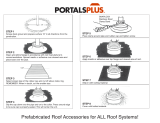
Location
Installing the Water Heater
This water heater must be installed in accordance with these instructions, local codes, utility
company requirements, and/or in the absence of local codes, use the latest edition of CAN/
CSA B149 – Natural Gas and Propane Installation Code. A copy can be purchased from the
Canadian Standards Association, 5060 Spectrum Way, Mississauga, Ontario L4W5N6.
The auxiliary catch pan
installation MUST conform to
local codes, if applicable.
Diameter of water
heater plus 2 in.
(5.1 cm) min.
Max.
2.75 in.
(7 cm)
WARNING: Combustible
construction refers to
adjacent walls and ceilings
and should not be confused
with combustible or
flammable products and
materials. Combustible and/
or flammable products and
materials should never be
stored in the vicinity of this
or any gas appliance.
NOTICE: DO NOT allow
the flammable vapour
sensor to become submerged
in water. Make sure the
catch pan is properly
drained.
Flammable
Vapour
Sensor
NOTICE: DO NOT allow
the catch pan to obstruct
the flammable vapour
sensor.
The water heater should not be located
in an area where leakage from the tank
or connections will result in damage
to the area adjacent to the heater or to
lower floors of the structure.
When such areas cannot be avoided it is
recommended that a suitable catch pan,
adequately drained, must be installed
under the water heater.
The water heater must be centered in the
catch pan.
Catch pan kits are available from the
store where the water heater was pur-
chased, or any water heater distributor.
Make certain the floor underneath the
water heater is strong enough to suf-
ficiently support the weight of the water
heater once it is filled with water.
This gas-fired water heater or any other
appliance should not be installed in a
space where liquids which give off flam-
mable vapours are to be used or stored.
Such liquids include gasoline, LP gas
(butane or propane), paint or adhesives,
thinners, solvents and/or combustible
removers.
DO NOT obstruct or block the
Flammable Vapour Sensor.
Because of natural air movement in a
room or other enclosed space, flammable
vapours can be carried some distance
from where liquids which give off flam-
mable vapours are to be used or stored.
The open flame of the water heater’s
main burner can ignite these vapours cre-
ating a shut down condition which will
not allow the water heater to ignite.
FVIR certified gas water heaters can be
installed on a residential garage floor
without the use of an 18 in. (46 cm) stand
in accordance with the CAN/CSA B149.1
- Natural Gas and Propane Installation
Code for Canadian installations, unless
otherwise directed by Province. The
water heater must be located so it is not
subject to physical damage, for example,
by moving vehicles, area flooding, etc.
● We recommend this water heater be
installed in locations where the ambi-
ent temperatures do not exceed 100°F
(38°C).
IMPORTANT: Do not install the
water heater in a location where it may
be subjected to ambient temperatures
exceeding 125°F (52°C).
● The water heater should be installed
so as to minimize the length of plastic
vent and combustion air-inlet pipe and
the number of vent and combination
air-inlet connection fittings required.
● See Vent and Combustion Air-Inlet
Section for vent system requirements.
● Hot water lines should be insulated to
conserve water and energy.
● Protect the water heater and water lines
from exposure to freezing tempera-
tures.
● DO NOT install this water heater out-
doors.
● Minimum clearances from combustible
construction:
FrontV
Sides Rear
TopVV
5 in.
(12.7 cm)
0 in.
(0 cm)
0 in.
(0 cm)
12 in.
(30.5 cm)
V "Front" Clearance dimension is mea-
sured from the water heater jacket to
the closet door.
VV "Top" clearance dimension is mea-
sured from the jacket top of the
water heater to the ceiling.
● If the water heater is to be installed
directly on carpeting, the water heater
shall be installed on a metal or wood
panel extending beyond the full width
and depth of the water heater by at
least 3 in. (7.6 cm) in all directions or,
if the water heater is to be installed
in an alcove or closet, the entire floor
must be covered by a wood or metal
panel.
7























